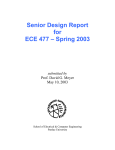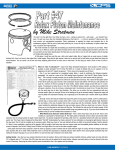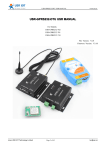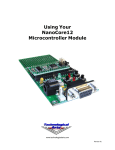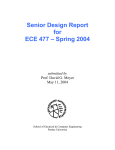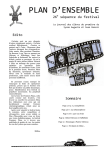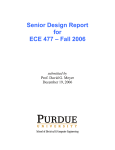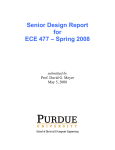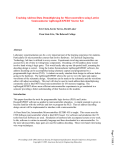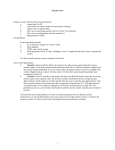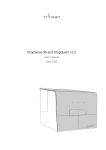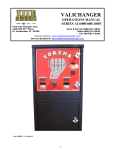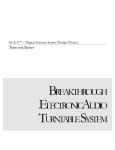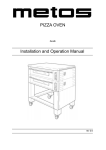Download Spring 2005 - College of Engineering
Transcript
Senior Design Report for ECE 477 – Spring 2005 submitted by Prof. David G. Meyer May 10, 2005 School of Electrical & Computer Engineering Purdue University Senior Design Report ECE 477 – Spring 2005 Contents Overview ……………………………………………………………………………………… 1 Self-Evaluation ……………………………………………………………………………….. 1 Course Policies and Procedures ………………………………………………………………. 2 Grade Determination ………………………………………………………………………….. 3 Lecture Schedule ……………………………………………………………………………… 4 Design Project Specifications ………………………………………………………………… 5 Milestones …………………………………………………………………………………….. 7 Outcome Assessment …………………………………………………………………………. 8 Appendix A: Senior Design Reports Appendix B: Proposed Evaluation Form Appendix C: ECE Course Assessment Report -ii- Senior Design Report ECE 477 – Spring 2005 Overview One of the unique features of ECE 477, Digital Systems Senior Design Project, is that each team gets to choose their own specific project (subject to some general constraints) and define specific success criteria germane to that project. In general, this approach to senior design provides students with a sense of project ownership as well as heightened motivation to achieve functionality. All project teams this semester successfully designed and built a printed circuit board, achieved at least basic functionality of their microcontroller-based hardware, and successfully integrated their application software. Some groups, in fact, continued to work on their projects after the semester was over (“just for fun”), to add features and/or obtain a higher degree of functionality. In short, students not only devoted a lot of time to this course, but they also learned a lot – in the words of several students, “more than in all their other ECE courses combined.” The complete set of Senior Design Reports is included as Appendix A. Self-Evaluation The high degree of success achieved by each team was a direct result of the effort of the course staff (Profs. Dave Meyer and Mark Johnson) spending a significant amount of time consulting with each team. Another reason for the high degree of success attained was the sustained effort put forth by the teaching assistants, Brian Moerdyk and Nick Schnettler. The course staff is quite pleased with the rigorous, quantitative assessment of the course outcomes. A new addition this semester was formally including a poster as one of the documentation requirements. Also, PPT “skeleton” files were made available to help make the formal presentations and the ECE 270/362 promotional presentations more uniform. There is always room for change, however, and one of our goals has always been to strive for continuous improvement. A problem inherent in all “open-ended” project courses is the tractability of the student-chosen design projects. The staff needs to be more “forceful” in rejecting project proposals that are too ambitious and in suggesting alternative ideas. Also, the course and instructor evaluation forms used by the senior design courses (in particular, EE 402 and EE 477) need to be revamped. (The forms developed for EPICS were used by “default” until they no longer were made available to us – currently, there is no uniform evaluation mechanism for the senior design courses.) I have developed an alternative form (revised this semester), and have used it on an experimental basis in ECE 477 for several semesters. I will (once again attempt to) present the idea of a “universal senior design evaluation form” to the ECE Senior Design Advisory Committee at its next meeting. Web-based evaluation opens the possibility of “customized” forms based on the type of course and the personnel to be evaluated. Finally, the ECE Administration is encouraged to remain cognizant of the fact that ECE 477 is not a “standard 3-credit hour” load – the amount of evaluation and consultation required is several times that of a “normal” course. The “record” 56 students/14 teams enrolled this semester stretched the course staff and facilities to their limit. With 48 students scheduled for Fall 2005, it is important not only to have two faculty involved, but also at least 1.0 FTE T.A. as well (an enrollment of 48 students translates into 12 independent project teams). -1- Senior Design Report ECE 477 – Spring 2005 Course Policies and Procedures Course Description: A structured approach to the development and integration of embedded microcontroller hardware and software that provides senior-level students with significant design experience applying microcontrollers to a wide range of embedded systems (e.g., instrumentation, process control, telecommunication, intelligent devices, etc.). Objective: To provide practical experience developing integrated hardware and software for an embedded microcontroller system in an environment that models one which students will most likely encounter in industry. Instructors: Prof. D. G. Meyer, [email protected], Office: MSEE 238, Phone: 494-3476; and Prof. Mark Johnson, [email protected], Office: EE 268, Phone: 494-0636. Course Teaching Assistants: Brain Moerdyk ([email protected]) and Nick Schnettler ([email protected]). Course web site: http://shay.ecn.purdue.edu/~dsml/ece477 Course E-mail address: [email protected] Office Hours: Scheduled office hours will be posted on the course web site; other times may be arranged by E-mail appointment. Please make use of the “live” consultation hours available rather than E-mailing “long” or detailed questions specific to your project. Open Shop Lab: Room EE 067 is the laboratory for this course; students enrolled in ECE 477 will be given a key code that will provide them with 24-hour access. This facility is equipped with expensive, state-of-the-art instrumentation; students are expected to treat the equipment and furnishings with respect. There will be a “zero tolerance” policy for abuse/misuse of this lab: anyone who does so will be unceremoniously dropped from the course, receive a failing grade, and be prohibited from re-registering for the course. Theft will be prosecuted. Design Project: Of utmost importance in the "real world" is the ability to document and present technical information in a clear, organized, succinct, and well-illustrated fashion. In microprocessor-based designs, the ability to integrate hardware and software is a fundamental skill that should be possessed by all Computer Engineering graduates. The design project, formal written report, and videotaped presentation will give each student in this course the opportunity to develop these skills. Students will work on their design in teams of four. Lab Notebook: Developing good design documentation skills is an important part of this course. A significant part of your grade (10%) will be based on the individual lab notebook you maintain throughout the design and development process. Weekly Meetings: During a scheduled (10-minute) portion of the weekly lab period for this course (8:00 AM – 10:20 AM on Wednesdays), each team will meet with the course staff to discuss progress on the design project. Each team member will be expected to post a completed weekly progress report on their team’s project web site in advance of these meetings. -2- Senior Design Report ECE 477 – Spring 2005 Group Account and Team Webpage: Each team will be assigned an ECN group account to use as a repository for all their project documentation and for hosting a password-protected team web page. The team web page should contain datasheets for all components utilized, the schematic, board layout, software listings, interim reports, presentation slides, etc. It should also contain the individual lab notebooks for each team member as well as the progress reports (prepared in advance of the weekly progress briefings) for each team member. At the end of the semester, each team must submit a CD-ROM archive of the group account. Homework: Several “homeworks” will be assigned related to key stages of the design project. Some of the assignments will be completed as a team (1, 2, 3, 12, 14, 15, 16), one will be completed individually (13), and some will be completed by a selected team member (one from the set {5, 6, 7, 10} and one from the set {4, 8, 9, 11}). 1. 2. 3. 4. 5. 6. 7. 8. 9. 10. 11. 12. 13. 14. 15. 16. These assignments are due at Preliminary Design Project Proposal CLASSTIME on the prescribed due Final Design Project Proposal dates. The following penalties will OrCAD Exercise be applied for work submitted late: Design Constraint Analysis and Component Selection Rationale 5% if submitted by 5:00 PM the Packaging Specifications and Design day it was due (Thursday) Schematic and Hardware Design Narrative/Theory of Operation 10% if submitted by 5:00 PM the Board Layout day after it was due (Friday) Patent Liability Analysis 20% if submitted by 8:00 AM the Reliability and Safety Analysis following Monday Firmware Listing and Software Narrative 30% if submitted by 5:00 PM the Social/Political/Environmental Analysis following Monday User Manual 100% if submitted any later Confidential Peer Review Senior Design Report These assignments are all due on May 4, 2005, at 5:00 PM. A penalty Final Report & Archive CD of 10% per day late will be assessed on these items through 5:00 PM Poster on Friday, May 6, after which time they will no longer be accepted. Grade Determination Your course grade will be based on both team effort (50%) and individual contributions (50%): TEAM COMPONENTS Design Review Final Video Presentation Final Report & Archive CD {15} Project Success Criteria Satisfaction Project Proposal {1 & 2} User Manual {12} Senior Design Report {14} Poster {16} 10% 10% 10% 10% 2% 3% 2% 3% INDIVIDUAL COMPONENTS Significance of Individual Contribution Lab Notebook Eval (Midterm & Final) Design Component {5, 6, 7, or 10} Professional Component {4, 8, 9, or 11} OrCAD Exercise {3} Presentation Peer Review {DR + FP} Confidential Peer Review {13 } Weekly Progress Briefings/Attendance 10% 10% 10% 10% 2% 4% 2% 2% Your Raw Weighted Percentage (RWP) will be calculated based on the weights, above, and then "curved" (i.e., mean-shifted) with respect to the upper percentile of the class to obtain a Normalized Weighted Percentage (NWP). Equal-width cutoffs will then be applied based on the Windowed Standard Deviation (WSD) of the raw class scores; the minimum Cutoff Width Factor (CWF) used will be 10 (i.e., the nominal cutoffs for A-B-C-D will be 90-80-7060, respectively). Before final grades are assigned, the course instructor will carefully examine all "borderline" cases (i.e., NWP within 0.5% of cutoff). Once grades are assigned, they are FINAL and WILL NOT be changed. Note that all course outcomes (listed on page 7 of this document) must be demonstrated in order to receive a passing grade for the course. -3- Senior Design Report ECE 477 – Spring 2005 Lecture Schedule: Week 1 Tu – course and project overview, team formation Th – project proposal guidelines and documentation requirements Week 2 Tu – digital system design considerations Th – printed circuit board layout basics Week 3 Tu – real-world design constraints Th – product packaging considerations Week 4 Tu – survey of alternative microcontrollers for embedded applications Th – embedded system interfacing: switching D.C. loads, optical isolation Week 5 Tu – embedded system interfacing: keypads, switch de-bouncers, RPGs, PWM Th – embedded system interfacing: position control, steppers, A.C. loads Week 6 Tu – power supply design – basic considerations, linear regulators Th – power supply design – switching regulators, DC-DC converters Week 7 Tu – capacitor and resistor selection guidelines Th – patent infringement liability Week 8 Tu – (no class – formal design reviews individually scheduled this week) Th – (no class – formal design reviews individually scheduled this week) Week 9 Tu – design for reliability, maintainability, and safety Th – failure mode and risk analysis Week 10 Tu – board assembly and soldering techniques Th – embedded software development Week 11 Tu – interactive “broken board” debugging Th – ethical/social/political/environmental considerations Week 12 Tu – user manual, poster, final report, and final presentation guidelines Th – user manual, poster, final report, and final presentation guidelines Week 13 Tu – current embedded system topics Th – current embedded system topics Week 14 Tu – (no class) Th – (no class) Week 15 Tu – (no class – final project presentations individually scheduled this week) Th – (no class – final project presentations individually scheduled this week) -4- Senior Design Report ECE 477 – Spring 2005 Design Project Specifications Work on the design project is to be completed in teams of four students. The design project topic is flexible, and each group is encouraged to pick a product that uses the strengths and interest areas of their group members. The design must have the following components: • Microprocessor: To help make the project tractable, microprocessor choices will be limited to 68HC12, PIC, Rabbit, and Atmel variants. Development tools are readily available in lab to support these devices. Further, the devices themselves are relatively low cost and readily available. • Interface to Something: Your embedded system must interface to some other device or devices. It could be a computer, or it could be some embedded device such as a Palm Pilot, telephone line, TV, etc. Some interface standards that could be used are: serial to a computer, parallel to a computer, Universal Serial Bus (USB), Firewire, Ethernet, Infrared (IR), Radio Frequency (RF), etc. This requirement has a large amount of freedom. To help with some of the more complex interfaces such as Ethernet, USB, or Firewire there are dedicated chips which encapsulate the lowest layers of the interface. This makes using these interfaces easier to handle but not necessarily trivial. Be sure to investigate the interface(s) you wish to utilize and make a reasonable choice. (NOTE: Interfaces involving A.C. line current require special permission – see the instructor for details.) • Custom printed circuit board: Through the process of the design, each group will be required to draw a detailed schematic. From the schematic, a two-layer (maximum) printed circuit board will be created. Board etching will be processed by the ECE Department (the first one is “free”, but any subsequent iterations are the team’s responsibility). The team is then responsible for populating the board (solder the parts on the board), and for completing the final stages of debugging and testing on their custom board. • Be of personal interest to at least one team member: It is very difficult to devote the time and energy required to successfully complete a major design project in which you and/or your team members have no personal interest. There are lots of possibilities, ranging from toys and games to “useful and socially redeeming” household items, like audio signal processors and security systems. • Be tractable: You should have a “basic idea” of how to implement your project, and the relative hardware/software complexity involved. For example, you should not design an “internet appliance” if you have no idea how TCP/IP works. Also, plan to use parts that are reasonably priced, have reasonable footprints, and are readily available. Be cognizant of the prototyping limitations associated with surface mount components. • Be neatly packaged: The finished project should be packaged in a reasonably neat, physical sound, environmentally safe fashion. Complete specification and CAD layout of the packaging represents one of the project design components. • Not involve a significant amount of “physical” construction: The primary objective of the project is to learn more about digital system design, not mechanical engineering! Therefore, most of the design work for this project should involve digital hardware and software. -5- Senior Design Report ECE 477 – Spring 2005 Project Proposal Each group should submit a proposal outlining their design project idea. This proposal should not be wordy or lengthy. It should include your design objectives, design/functionality overview, and project success criteria. The five success criteria common to all projects include the following: • • • • • Create a bill of materials and order/sample all parts needed for the design Develop a complete, accurate, readable schematic of the design Complete a layout and etch a printed circuit board Populate and debug the design on a custom printed circuit board Package the finished product and demonstrate its functionality In addition to the success criteria listed above, a set of five significant project-specific success criteria should be specified. The degree to which these success criteria are achieved will constitute one component of your team’s grade. Forms for the preliminary and final versions of your team’s project proposal are available on the course web site. Use these skeleton files to create your own proposal. Note that the proposal should also include assignment of each team member to one of the design components as well as to one of the professional components of the project. Design Review Part way through the design process, there will be a formal design review. This is a critical part of the design process. In industry, this phase of the design process can often make or break your project. A good design review is one where a design is actively discussed and engineers present concur with the current or amended design. The design review is in some cases the last chance to catch errors before the design is frozen, boards are etched, and hardware is purchased. A friend is not someone who rubber-stamps a design, but rather one who actively challenges the design to confirm the design is correct. Approach the design review from a top-down, bottom-up perspective. First, present a block diagram of your design and explain the functional units. Then drop to the bottom level and explain your design at a schematic level. Be prepared to justify every piece of the design; a perfectly valid answer, however, is applying the recommended circuit from an application note. If you do use a circuit from an application note, have the documentation on hand and be able to produce it. Your grade for the design review will not be based on the number of errors identified in your design. The best engineers make mistakes, and the purpose of the design review is to catch them rather than spend hours of debugging later to find them. The design review will be graded primarily on how well the group understands their design and the professionalism with which they present it. To facilitate the design review process, the class will be split into subgroups that will meet at individually scheduled times. Both the presenters and the assigned reviewers will be evaluated. -6- Senior Design Report ECE 477 – Spring 2005 Milestones Each group is responsible for setting and adhering to their own schedule; however, there are several important milestones, as listed in the table below. Always “expect the unexpected” and allow for some buffer in your schedule. Budget your time. Week 1 Jan 10 – Jan 14 Formulate Group and Project Ideas Week 2 Jan 17 – Jan 21 Preliminary Project Proposal Due Week 3 Jan 24 – Jan 28 • • • Research parts Create block diagram Begin ordering/sampling parts Final Project Proposal Due Week 4 Jan 31 – Feb 4 Review/Learn OrCAD Capture & Layout Week 5 Feb 7 – Feb 11 Week 6 Feb 14 – Feb 18 • • • • Draw schematic Create bill of materials Prototype interface circuits Begin software development using EVB Schematic and Parts List Due • Do preliminary PCB layout • Continue software development • Prepare for Design Review Design Reviews Week 7 Feb 21 – Feb 25 Week 8 Feb 28 – Mar 4 • • • Week 9 Mar 7 – Mar 11 Board Layout Due Week 10 Mar 21 – Mar 25 Week 11 Mar 28 – Apr 1 • • • Week 12 Apr 4 – Apr 8 Software/HDL Documentation and Listings Due Week 13 Apr 11 – Apr 15 Week 14 Apr 18 – Apr 22 Week 15 Apr 25 – Apr 29 • Hardware/software integration and testing • Make videos of project success criteria demonstrations • Prepare presentation and begin writing reports Project Demonstrations and Final Presentations Week 16 May 2 – May 6 Modify schematic based on Design Review feedback Continue software development Finalize PCB layout and prepare design for submission Populate printed circuit board Continue software development Debug hardware on printed circuit board Archive CD, Confidential Peer Review, Final Report, Poster and Senior Design Report due May 4 at 5 PM -7- Senior Design Report ECE 477 – Spring 2005 Outcome Assessment In order to successfully fulfill the course requirements and receive a passing grade, each student is expected to demonstrate the following outcomes: (i) an ability to apply knowledge obtained in earlier coursework and to obtain new knowledge necessary to design and test a microcontroller-based digital system [1, 2, 3, 4, 5; a, b, c, e, i, j, k] (ii) an understanding of the engineering design process [4, 6, 7; b, c, e, f, h] (iii) an ability to function on a multidisciplinary team [6, 7; d, h, j] (iv) an awareness of professional and ethical responsibility [6, 7; f, h, j] (v) an ability to communicate effectively, in both oral and written form [6; g] The following instruments will be used to assess the extent to which these outcomes are demonstrated (the forms used to “score” each item are available on the course web site): Outcome (i) (ii) (iii) (iv) (v) Evaluation Instruments Used Design Component Homework Individual Lab Notebooks (two separate evaluations) Success Criteria Satisfaction (general and project-specific) Professional Component Homework Formal Design Review, Final Presentation, and Final Report Students must demonstrate basic competency in all the course outcomes, listed above, in order to receive a passing grade. Demonstration of Outcome (i) will be based on the satisfaction of the design component homework, for which a minimum score of 60% will be required to establish basic competency. Demonstration of Outcome (ii) will be based on the individual lab notebook, for which a minimum score (on the second of two evaluations) of 60% will be required to establish basic competency. Demonstration of Outcome (iii) will be based on satisfaction of the general and project-specific success criteria, for which a minimum score of 70% will be required to establish basic competency. Demonstration of Outcome (iv) will be based on the professional component homework, for which a minimum score of 60% will be required to establish basic competency. Demonstration of Outcome (v) will be based on the Design Review, the Final Presentation, and the Final Report. A minimum score of 60% on the Design Review and a minimum score of 60% on the Final Report and a minimum score of 60% on the Final Presentation will be required to establish basic competency. Since senior design is essentially a “mastery” style course, students who fail to satisfy all outcomes but who are otherwise passing (based on their NWP) will be given a grade of “I” (incomplete). The grade of “I” may subsequently be improved upon successful satisfaction of all outcome deficiencies. If outcome deficiencies are not satisfied by the prescribed deadline, the grade of “I” will revert to a grade of “F”. -8- Senior Design Report ECE 477 – Spring 2005 Appendix A: Senior Design Reports Senior Design Report ECE 477 – Spring 2005 Purdue ECE Senior Design Semester Report Course Number and Title Semester / Year Advisors Team Number Project Title ECE 477 Digital Systems Senior Design Project Spring 2005 Prof. Meyer and Prof. Johnson 1 FIREbot Senior Design Students – Team Composition Area(s) of Expertise Name Major Utilized in Project Nathan Ainsworth CmpE Embedded Software Nakul Jeirath CmpE Andrew Penner CmpE DSP Zeeshan Khan CmpE Scripting Expected Graduation Date May 2005 May 2005 May 2005 May 2005 Project Description: Provide a brief (one or two page) technical description of the design project, as outlined below: (a) Summary of the project, including customer, purpose, specifications, and a summary of the approach. The Fully Integrated Robot Extinguishing robot (FIREbot) is a fully autonomous robot which detects, approaches, and extinguishes a small class A, B, or C flame on the ground. It is intended for use in a home or small office, and carries a standard household fire extinguisher. Detection and pinpointing of flames is performed through an array of infrared and ultra-violet sensors. A microcontroller running local software reads the sensors, makes decisions based upon their values, and drives several drive motors and servos to control the actions of the robot. An LCD display shows the current state of the robot and provides feedback to the user. The robot is built on a small flat platform, which carries the motors, sensors, fire extinguisher, and electronics of the robot. Therefore, these components are physically small and light. The FIREbot is powered by an onboard rechargeable battery, and the robot consumes a minimum of power. (b) Description of how the project built upon the knowledge and skills acquired in earlier ECE coursework. The FIREbot Project involved the use of the following technical skills learned in ECE courses: i. Analog Electronic Design ii. Digital Electronic Design iii. Microcontrollers Interfacing iv. Control Systems v. Real-Time Software vi. Digital Signal Processing Senior Design Report ECE 477 – Spring 2005 (c) Description of what new technical knowledge and skills, if any, were acquired in doing the project. The following new technical skills were developed in senior design: i. PID Controllers ii. Difference Engines iii. PCB Design (d) Description of how the engineering design process was incorporated into the project. Reference must be made to the following fundamental steps of the design process: establishment of objectives and criteria, analysis, synthesis, construction, testing, and evaluation. The engineering design process was well integrated into the course. Several weeks were spent on the development of project objectives. A constraint analysis document was written which determined part selection and system design. Documents covered each of packaging design, circuit design, layout, and software design. Construction of the Firebot occurred in parallel with design of other components, and each component was tested separately and then as a part of larger systems. Finally, the performance of the entire Firebot was tested. (e) Summary of how realistic design constraints were incorporated into the project (consideration of most of the following is required: economic, environmental, ethical, health & safety, social, political, sustainability, and manufacturability constraints). Regular homeworks established milestones in the engineering design process, and included works on Project Proposal, Constraint Analysis, Reliability and Safety, Ethical and Environmental Considerations, etc. (f) Description of the multidisciplinary nature of the project. The FIREbot project involved a large number of technical disciplines. Systems engineering was required for the concept and structure of the project as a whole. Mechanical design was involved in the design of the robot’s physical structure. Both analog and digital electronic design were involved in the development of the electronics, including power supply design, signal amplification, microcontroller interfacing, etc. The software development involved real-time applications, controls, and artificial intelligence. This caused all team members to learn these many different fields, as well as learning to integrate all the individual parts into the whole. . Senior Design Report ECE 477 – Spring 2005 Purdue ECE Senior Design Semester Report Course Number and Title Semester / Year Advisors Team Number Project Title ECE 477 Digital Systems Senior Design Project Spring 2005 Prof. Meyer and Prof. Johnson Group 2 Double Deuce Alarm System Senior Design Students – Team Composition Area(s) of Expertise Name Major Utilized in Project Jacob Schroeder CmpE C programming, Java programming, network protocols Brian Stratman CmpE Embedded design, hardware debugging, C programming Blake Shelby EE Circuit Analysis, hardware debugging, PCB layout Michael Tammen EE Circuit Analysis, hardware debugging, schematic design Expected Graduation Date May 2005 May 2005 May 2005 May 2005 Project Description: Provide a brief (one or two page) technical description of the design project, as outlined below: (a) Summary of the project, including customer, purpose, specifications, and a summary of the approach. The Double Deuce Alarm System (DDAS) is a home security and monitoring system. It is basically an extension upon current home security systems. The DDAS includes the basic functionalities of a home security system: the ability to monitor sensors, the ability to be armed or disarmed, and the ability to sound an alarm when a sensor is tripped. In addition, the DDAS hosts a static webpage which contains a java applet. This java applet reports the status of the system and the status of each sensor to a user friendly user interface. Through the applet, It is also possible to arm and disarm the system, in addition to renaming and enabling/disabling individual sensors. Email alerts are also sent whenever the alarm is tripped by utilizing a simple on-chip SMTP client. The target customer is any homeowner who is concerned about protecting his property and his loved ones. This system can be easily installed in any home, although installation is easier if done during home construction, as it will be easier to run sensor wires. The purpose of the DDAS is to provide a web enabled home security and monitoring system. The web interface should allow for remote monitoring and configuration. The specifications include implementing the standard security system features mentioned above, in addition to adding Senior Design Report ECE 477 – Spring 2005 the “web enabled” features also outlined above. The approach was to use a Freescale MC9S12NE64 microcontroller as the brains of the DDAS and swappable module cards into which the individual sensors would plug into. (b) Description of how the project built upon the knowledge and skills acquired in earlier ECE coursework. The project built upon several skills acquired in earlier coursework. C programming (ECE264) was used to write the code on the microcontrollers (Freescale and Atmel). In addition, Java programming (ECE462) was used to write the Java Applet hosted on the Freescale microcontroller. Basic microcontroller knowledge and debugging skills (ECE362) were used during component selection and hardware debugging. Digital logic (ECE270) skills were used during the initial design stages when choosing the hardware for the design. In addition, a background in the workings of transistors (ECE255) came in handy when choosing the transistors needed in the design. (c) Description of what new technical knowledge and skills, if any, were acquired in doing the project. The team gained knowledge and insight into the following protocols as they were implemented during this project: UDP, TCP/IP, SMTP, and HTTP. In addition, the team became familiar with I2C as they initially hoped to integrate that into the project; however, due to time constraints this was moved to a future revision enhancement. The team learned how to create a printed circuit board layout given a design schematic. Additionally, more experience was gained with regards to hardware debugging, especially of microcontrollers. In addition to the technical skills gained, the team gained more experience in a design team environment, in working with a design schedule, and in giving formal presentations. (d) Description of how the engineering design process was incorporated into the project. Reference must be made to the following fundamental steps of the design process: establishment of objectives and criteria, analysis, synthesis, construction, testing, and evaluation. The Double Deuce Alarm System was implemented in a series of steps following the fundamental steps of the design process. Initially, the team met to discuss what it wanted to design. Once the team knew what the design would be, it put together a series of objectives and criteria - this is when the Project Specific Success Criterion (PSSC) was established. The next step was to research (analysis) ways of meeting the objectives and then to start creating the design (synthesis) by designing a schematic and board layout. The team met with course staff to review the design (analysis) to get the approval before construction began. Once the design was constructed, testing had to be done to verify that the established PSSC and objectives were. These were filmed to demonstrate criteria satisfaction to the course staff which will be providing a grade (evaluation) for the team based upon our performance and design. This is in addition to our own candid evaluation given during our final presentation. Senior Design Report ECE 477 – Spring 2005 (e) Summary of how realistic design constraints were incorporated into the project (consideration of most of the following is required: economic, environmental, ethical, health & safety, social, political, sustainability, and manufacturability constraints). Many realistic design constraints were incorporated into the Double Deuce Alarm System. For example, various failure modes of the system were designed such that in case of failure, the system would not harm any individual nor cause a hazardous situation (fire). In addition, during the design phase several environmental and ethical concerns were addressed regarding our design and the use of the battery backup system. Steps were outlined on ways to inform the customer of the hazardous nature of batteries and their proper disposal. Constraints such as sustainability and manufacturability were considered every step of the way as a working prototype was designed and manufactured. One of the objectives of the project was to create a project that could be mass produced efficiently; therefore, every step of the way consideration was taken to ensure manufacturability and sustainability when designing the schematic, layout, packaging design, and user manual. The social and political constraints were considered as extensive searches of the patent database were made to ensure that our design was not infringing upon any pre-existing patents. (f) Description of the multidisciplinary nature of the project. The Double Deuce Alarm System was inherently multidisciplinary. The brain of the system runs on a Freescale MC9S12NE64 microcontroller which was programmed using C. The schematic was designed from the ground up with custom layout on a printed circuit board for the project. Knowledge of Internet communication protocols such as UDP, TCP/IP, SMTP, and HTTP came in rather handy when designing the web server. Additionally, mechanical knowledge was used when designing the packaging, especially when considering what kind of material to construct the box housing from. Several of the homework assignments throughout the duration of the project forced the team to think about non-technical aspects such as the user interface (user manual), ethical implications (economic and ethical analysis), and the patent analysis just to name a few. As you can see, the nature of the project ranged from hardware design and debugging to software design and debugging to designing the physical packaging to non-technical aspects such as ethical and environmental considerations. This project was rather multidisciplinary in nature. Senior Design Report ECE 477 – Spring 2005 Purdue ECE Senior Design Semester Report Course Number and Title Semester / Year Advisors Team Number Project Title Name Ankur Jain Ashish Toshniwal Dushyant Dwibedy Trushal Chokshi ECE 477 Digital Systems Senior Design Project Spring 2005 Prof. Meyer and Prof. Johnson 3 VoIP Connect Senior Design Students – Team Composition Area(s) of Expertise Major Utilized in Project Computer Engineer Software Design, Embedded Systems Electrical Engineer Software Design Computer Engineer Software Design, Packaging Electrical Engineer Hardware Design Expected Graduation Date May 2005 May 2005 May 2005 May 2005 Project Description: Provide a brief (one or two page) technical description of the design project, as outlined below: (a) Summary of the project, including customer, purpose, specifications, and a summary of the approach. Our project was to create a Voice over IP Phone system that would be used to make calls over the internet wherein the user would be able to enter an IP address to make a call to, and his/her analog voice signal will be digitized and sent through the Ethernet port over the internet to the particular IP address which when received will be converted back to its analog form. The status of a call was shown on an LCD screen. Our motivation behind the project was to reduce the cost of making long distance and over seas calls. The phone uses a 9V adapter and comes with an Ethernet cable which is used to connect to the internet. Once connected, the user can simply enter the IP address of another user and make a call. The software constantly checks for an incoming or an outgoing call. Incase of the former, a buzzer is initiated and incase of the latter, a request is sent to the other phone to check its availability. If available, a connection is made until either user disconnects. The packets are exchanged between the phones using UDP/IP protocol. (b) Description of how the project built upon the knowledge and skills acquired in earlier ECE coursework. The most significant contribution towards our project was that of ECE362 which was used the most. This class provided us with the basic knowledge of how to program a microcontroller and integrating different components to it. ECE 270 provided us with the knowledge of pull-up, pull-down resistors, decoupling capacitors and comparator circuits which was used while designing and implementing our circuit. ECE 201/202 and 255 also came into play in designing low pass filters and using diodes for our power supply Senior Design Report ECE 477 – Spring 2005 requirements. We used our lab skills gained through our lab classes ECE 207/208 in testing and debugging our hardware using scopes and logic analyzers. We used knowledge gained from ECE 264 and ECE368 while designing and developing our software and most importantly the knowledge of ECE 495R (Networking) which formed the backbone of the software for our project. (c) Description of what new technical knowledge and skills, if any, were acquired in doing the project. The most important skill we leant was taking an idea from conception and shaping it to reality. We started with an idea and formulated it by designing it, developing it and finally packaging it. In the process of formulating our idea, we acquired valuable skills in the form of: Orcad Capture and Layout for the hardware, CodeWarrior for the software and other skills like soldering and packaging the product. We also learnt how important it is to read the documentation since it is the most important aspect of designing and developing a product. (d) Description of how the engineering design process was incorporated into the project. Reference must be made to the following fundamental steps of the design process: establishment of objectives and criteria, analysis, synthesis, construction, testing, and evaluation. The engineering design process was well incorporated into the project with the help of the homework’s and project briefings which enabled us to accomplish all the fundamental steps of the design process. The design process started from the following: Establishment of objectives and criteria: We went through a number of possible projects before we could decide on pursuing with Voice over IP Phone system. After selecting our project, we had to specify five Project Specific Success Criteria’s which were to be met in order to demonstrate completion of our project. The PSSC’s were as follows: 1) 2) 3) 4) 5) Ability to enter an IP address with a keypad Ability to show status of a call through an LCD display Ability to convert analog signal to digital data and vise-versa Ability to receive an incoming call Ability to have a full-duplex conversation Analysis: Once all our PSSC’s were approved, we started working on looking for components for our design. We went through different possibilities for every component and made sure we were satisfied with our selection. The design constraint analysis and component selection rationale homework helped us perform the analysis on choosing the right components for our design and building a rationale for our choices. Senior Design Report ECE 477 – Spring 2005 Synthesis: After choosing all the parts, we placed order for them and worked at designing our PCB. Once the parts were received, we made sure the footprints matched and submitted it in for fabrication. Construction: Once we received our PCB, we started populating it with individual components and tested it as we placed them. At the same time, we used the evaluation board to develop our software and clear out our PSSC’s one by one. Testing: Once our PCB was fully populated, we started testing individual components of our software to integrate on our board. Once, that was done, we integrated all the components and tested them to make sure the entire design works. Evaluation: Once, all the code was integrated, the project was evaluated on whether it met and satisfied all the Project Success Criteria’s. (e) Summary of how realistic design constraints were incorporated into the project (consideration of most of the following is required: economic, environmental, ethical, health & safety, social, political, sustainability, and manufacturability constraints). (f) Description of the multidisciplinary nature of the project. Our project was multidisciplinary in nature since it required the skills of an electrical engineer to design the circuit and the knowledge of a computer engineer for software development. Other than that, we required soldering and packaging skills to give our product a good look. Senior Design Report ECE 477 – Spring 2005 Purdue ECE Senior Design Semester Report Course Number and Title Semester / Year Advisors Team Number Project Title ECE 477 Digital Systems Senior Design Project Spring 2005 Prof. Meyer and Prof. Johnson 4 The PicPocket Senior Design Students – Team Composition Area(s) of Expertise Name Major Utilized in Project Mike Martin CmpE Programming Bill Dwyer CmpE Programming, CG Phillip Cadle CmpE Hardware Konstantin Grigoryan CmpE Soldering, HW design Expected Graduation Date May 2005 May 2005 May 2005 May 2005 Project Description: Provide a brief (one or two page) technical description of the design project, as outlined below: (a) Summary of the project, including customer, purpose, specifications, and a summary of the approach. The PicPocket is a handheld storage device that bridges the price gap between existing portable storage solutions such as Flash memory and traditional magnetic disc storage. While off-the-shelf Flash memory such as CompactFlash or SmartMedia are incredibly convenient for mobile applications such as digital cameras, they have relatively high cost/ capacity ratio; around $100.00 per Gigabyte. Hard drives, on the other hand, have incredibly low cost/capacity ratios; under $1.00 per Gigabyte! The PicPocket will be designed to minimize cost and size, which gives the user the impression that they can have many Gigabytes of storage for all their mobile applications. (b) Description of how the project built upon the knowledge and skills acquired in earlier ECE coursework. In ECE 270, the basics of digital circuits were laid down. In ECE 362, the fundamentals for microprocessor programming and peripheral interfacing were learned. In ECE ??? (OS), the workings of file systems were learned. All of these three areas were used in this project: our device utilizes an Atmel ARM microprocessor, as well as many of its peripherals such as the Extended Bus Interface (to communicate with the hard drive (HDD)), Serial Port Interface (to program the microcontroller), Background Debug interface (to debug the design), and Programmable IO (to communicate with the liquid crystal display (LCD)). The basics of digital circuit design were necessary to design the schematic and printed circuit board (PCB) layout accurately. Finally, a thorough understanding of file systems was necessary to design the file system we used in our design. Senior Design Report ECE 477 – Spring 2005 (c) Description of what new technical knowledge and skills, if any, were acquired in doing the project. We learned how to use layout tools for printed circuit board design (Mike), how to solder (Phillip), how to read data sheets carefully and debug hardware/software using various tools and equipment (Konstantin) and how to write a file system (Bill). (d) Description of how the engineering design process was incorporated into the project. Reference must be made to the following fundamental steps of the design process: establishment of objectives and criteria, analysis, synthesis, construction, testing, and evaluation. In the first two weeks, we considered multiple ideas and decided on one that we felt was the most tractable for our team in the time we had. We also created project success criteria that would form the basis of our overall objectives for the project. After this, we began choosing which parts would best fit our design and have the functionality that we needed. We also performed various analyses on our design throughout the semester when we considered the design of our packaging, our schematic, our PCB layout, and our software. As the semester progressed and we completed various components of the design, we brought these parts together to build our final product. This included interfacing the software with the hardware and correctly interfacing various hardware components together (LCD, HDD, microcontroller). To physically construct our product, we had to populate our PCB with the various components we had selected, and build the packaging we had designed. We tested our design incrementally as each component of the overall design was completed (each section of the PCB, each external hardware component, each software module). Finally, we evaluated our overall design to see how it stood up in the face of reliability and safety concerns, environmental concerns, ethics, patent liability, ease of use, and whether our original design objectives were finally met. (e) Summary of how realistic design constraints were incorporated into the project (consideration of most of the following is required: economic, environmental, ethical, health & safety, social, political, sustainability, and manufacturability constraints). We had to pick parts that were low-priced yet still had the functionality we needed. Instead of nickel-cadmium, we decided to use lithium-ion batteries because they are better for the environment. In our design, we added certain features to software and hardware that would “fail safe” in the event of an unexpected failure. We made sure that our design would not conflict with any existing copyrights if it went to market. Finally, we made sure our design was small, such that the packaging would be easy and inexpensive to manufacture. (f) Description of the multidisciplinary nature of the project. Our design includes the use of a HDD and LCD. To design the schematic of our board, a grasp of digital and analog circuit design was necessary. The software necessary for our design required knowledge of file systems and event-based programming. We had to solder our board components ourselves, as well as make our physical packaging. Senior Design Report ECE 477 – Spring 2005 Purdue ECE Senior Design Semester Report Course Number and Title Semester / Year Advisors Team Number Project Title ECE 477 Digital Systems Senior Design Project Spring 2005 Prof. Meyer and Prof. Johnson 5 Pill Dispenser Senior Design Students – Team Composition Area(s) of Expertise Name Major Utilized in Project Andrew N. Mehl EE EE270/362, Orcad and Hardware Benjamin J. Romberger CompE Orcad, Circuit Design and Software interfacing Adam R. McNeal CompE Hardware interfacing and Design prototyping Jonathan W. Benetti CompE Software and Hardware interfacing Expected Graduation Date May 2005 May 2005 May 2005 May 2005 Project Description: Provide a brief (one or two page) technical description of the design project, as outlined below: (a) Summary of the project, including customer, purpose, specifications, and a summary of the approach. The project undergone was the creation of a pill dispenser. The pill dispenser created was able to hold four types of pills at a time with interchangeable amounts. The user would be able to enter in times for each pill, and at that time, the proper pill would be dispensed and a buzzer would be sounded to alert the user. The pill dispenser is able to display dispensing times, pill information, current time, pills remaining, warnings and other pertinent information through an LCD interface. The user is also able to scroll through information displayed and through menus by using the LCD by using two buttons on the case. The pill dispenser works with a serial interface so that the user will be able to enter important information through a computer interface. When pills need to be dispensed, servos push the pills out of the interchangeable cartridges. The dispenser even provides safety by providing a lockable top and a switch inside the lockable area that needs to be flipped in order to switch into administration mode and alter important information. The dispenser also connects to a “wal-wart” for power and even contains a nine volt battery for a short term back up. One of the most important features of the pill dispenser is its expandability. The pill dispenser can support various add-ons including sensors, full audio, Ethernet functionality and even the ability to call a doctor. This design allows for a reliable, expandable and affordable pill dispenser. Senior Design Report ECE 477 – Spring 2005 When thinking of a project, the team wanted to do something that would help others. The purpose of the pill dispenser is to help people, specifically the elderly and those with memory problems, with taking their medications so that they could take their prescriptions at the proper times to keep them healthy and to avoid overdosing and under-dosing. The pill dispenser was meant for both individual issue and for issue upon a doctor’s request. When sold to individuals the lockable top and toggle to administration mode would still be there and it would be the user’s option to lock the top. If the dispenser was bought by a doctor for a patent, depending on the severity of the patent tampering with the system and the supervision given to the patent, certain functions such as sensors and the functionality of calling your doctor may need to be added. Whatever situation it was used in, it should provide help to many who need it. The approach of this project was clear yet tasking. The team first started out with the vision of a pill dispenser. Then they figured out what functionality they wanted, and began searching for parts. While parts were arriving, time was spent on drawing up a schematic, making the packaging and designing a layout for a PCB. Then the layout was sent off to be made and returned. Once the PCB was returned, it was populated with components and then fitted into the casing. After that, time was spent programming the microcontroller and working on the motor mechanism. Then the project was finally done and time was spent fine tuning all aspects. Due to class homework, many other issues we though about on the way including safety, reliability, environmental concerns, ethical concerns and patent infringements. This process worked perfectly and contributed to the success of the project. (b) Description of how the project built upon the knowledge and skills acquired in earlier ECE coursework. This project built on previous knowledge and skills in many ways. Programming and interfacing with the microcontroller built on previous experiences in ECE270/362. Working on the schematic and testing components built on knowledge from ECE201/202, their respective labs and ECE255. Soldering and working with OrCad also built on certain members past experiences with them. Many of the past ECE course also helped by offering projects with timelines which helped the team pace themselves and complete sub-goals on the way to a finished project. (c) Description of what new technical knowledge and skills, if any, were acquired in doing the project. Many of the team members acquired new knowledge through the project. For most members it was the first time they were introduced to OrCad and thus learned how to not only use Orcad, but how to layout a PCB and a schematic. A couple of the member even learned how to solder for the first time when it came to populating the PCB. The computer engineers in the group also used the C compiler for a PIC for the first time and learned many intricacies of the compiler. Besides those technical skills and knowledge, many members learned many minor pieces of knowledge about patent infringement and environmental effects of certain components, like the lead in the PCB being toxic. Senior Design Report ECE 477 – Spring 2005 (d) Description of how the engineering design process was incorporated into the project. Reference must be made to the following fundamental steps of the design process: establishment of objectives and criteria, analysis, synthesis, construction, testing, and evaluation. The design process was integrated into this project from day one, and helped to keep everything flowing throughout the semester. The project started with laying out the objectives and criteria in the first few weeks, the homework assignments and deadlines made sure it was on task. The project then really took off as it was evident how much work had to be done. The analysis and synthesis phases were completed with the selection of components and the design of the project. Once everything was gathered, building and testing the appliance came at a time when the real world assignments were due. The project was modified to fit practicality and budget. Overall it was a great success, and the design process certainly helped to make it so. (e) Summary of how realistic design constraints were incorporated into the project (consideration of most of the following is required: economic, environmental, ethical, health & safety, social, political, sustainability, and manufacturability constraints). This project took a wide variety of real world constraints into consideration in the design phase, and a few others along the way. To make it as safe and reliable as possible, popular commercial products were used in its construction, and it was encased in acrylic. Economic factors lead to the use of the most affordable parts, and eventually to the redesign of the motors/mechanics. Care was taken to make it as environmentally friendly as possible, and ethical situations were considered, a few features (like the locking lid) were added for these reasons. The project itself was chosen for social reasons, as there appears to be a need for a product like this. As evaluated in the end many revisions would take place before manufacturing would begin, but if done right it would have huge commercial potential. (f) Description of the multidisciplinary nature of the project. The project was very multidisciplinary as a large amount of different skills were needed in its completion. Individuals had to work with hardware and software, and several skills were needed in both areas. Work had to be done on a professional level with certain homework assignments, and real-world skills were used or gained. The participation in a team and strict deadlines added to the soft-skills aspect of the project. Mechanics had to be worked out as well. This was a true ‘engineering’ project, as many areas of study were utilized. Senior Design Report ECE 477 – Spring 2005 Purdue ECE Senior Design Semester Report Course Number and Title Semester / Year Advisors Team Number Project Title ECE 477 Digital Systems Senior Design Project Spring 2005 Prof. Meyer and Prof. Johnson 6 Arbuckle’s Automatic Pet Feeder Senior Design Students – Team Composition Area(s) of Expertise Name Major Utilized in Project KamBiu Chan (Team leader) EE Hardware & software Mike Lowe CmpE Software John Parlingdungan EE Hardware Eric Su CmpE Software Expected Graduation Date May 2005 May 2005 May 2005 May 2005 Project Description: Provide a brief (one or two page) technical description of the design project, as outlined below: (a) Summary of the project, including customer, purpose, specifications, and a summary of the approach. The product targets middle class pet owners. The primary goal of the project is to provide a convenient way for the busy owner to take care of their pets. In short, the product is designed to deliver a controlled amount of food to 4 different pets for up to 20 days with human intervention. The feeder will check for approaching cats by periodically scanning for RFID tags installed in the cats’ collars. It will identify each of them by comparing the information stored on the tag with those in the system’s database. The system will then dispense the food to the cat by powering on the auger style pet food dispenser if the cat approaches during the preset dining time window. Users will be able to modify the system settings by either using its onboard LCD and Rotary Pulse Switch or through an internet browser. The system will also generate email to alert the users when food is running low. (b) Description of how the project built upon the knowledge and skills acquired in earlier ECE coursework. The project has greatly utilized the material learned in classes studied earlier in the ECE curriculum. ECE 362 is the most important of all. Knowledge of registers, assembly code and I/O in embedded systems learned in 362 came in handy in many occasions when software was being written. Besides, ECE 264 and 368 has also built up a solid foundation programming skills and knowledge which is critical to success in this project. The ability to understand datasheet gained from 270 has proven to be very help during the components selection period. Other circuit courses like 201 and 255 also played an important role in the schematic design. Senior Design Report ECE 477 – Spring 2005 (c) Description of what new technical knowledge and skills, if any, were acquired in doing the project. The team has acquired knowledge about practical hardware development. The major skill that all of our members have learnt is PCB design and assembly. This is our first exposure to PCB layout design and soldering surface mounting components. We have also acquired a better understanding about microcontroller system. The team has learnt the functionality of parts that are not mentioned in EE362 (PLL, Oscillating crystal parameter calculations, Regulated power supply and etc.) (d) Description of how the engineering design process was incorporated into the project. Reference must be made to the following fundamental steps of the design process: establishment of objectives and criteria, analysis, synthesis, construction, testing, and evaluation. At the beginning of the semester, the team met to brainstorm for project ideas. We then proceed to outlining the successful criteria and objectives based on the ideas. These were detailed in the proposals. Throughout the course of the project, different sections of the project were divided among team members. Each member analyzed the requirements of the corresponding goal, and then actually synthesized and integrated this section. The data were then compiled together and integrated to the design. (e) Summary of how realistic design constraints were incorporated into the project (consideration of most of the following is required: economic, environmental, ethical, health & safety, social, political, sustainability, and manufacturability constraints). Ethically, we tried to make our product high quality and safe. Economically, we attempted to choose the most cost-effective solutions for implementation in order to make our product market competitive. We conducted reliability and safety analysis in order to make our product sustainable. We have also conducted social impact analysis and we identified negative impact to the human and pet relationship to be the biggest potential social impact. The team decided to address proper use of the project as a mean of convenient instead of a lazy way out. By avoiding patent infringement and using expensive components, the team has did a good job in increasing the manufacturability of the product. (f) Description of the multidisciplinary nature of the project. The project required high level understanding of electronic system design. The team needed to be able to work on both AC and DC circuit design as well as PCB layout. It also required in-depth understanding about embedded RTOS. We had to optimize our code to fit with the timing critical requirement of the system. Besides, a lot of mechanical skills were demanded during construction and fabrication of the packaging. The team also need to have a rich knowledge on both pet dieting behavior and owners’ typical problems with their pets. Senior Design Report ECE 477 – Spring 2005 Purdue ECE Senior Design Semester Report Course Number and Title Semester / Year Advisors Team Number Project Title ECE 477 Digital Systems Senior Design Project Spring 2005 Prof. Meyer and Prof. Johnson 7 GROVER (Ground-Roaming Offensive Vehicular Engagement Robot) Senior Design Students – Team Composition Area(s) of Expertise Name Major Utilized in Project Joel Stubbs CmpE Hardware/Software Des. Stan Miller EE Hardware/Software Des. Andrew Parcel CmpE Hardware/Software Des. Edwin Tjandranegara CmpE Hardware/Software Des. Expected Graduation Date May 2005 May 2005 May 2005 May 2005 Project Description: Provide a brief (one or two page) technical description of the design project, as outlined below: (a) Summary of the project, including customer, purpose, specifications, and a summary of the approach. Our project is an autonomous vehicle that is designed to look for human targets and engage them while patrolling a limited area and avoiding ground obstacles. Ultrasonic and passive IR sensors are integrated with an off-shelf vehicle and AirSoft weaponry. The vehicle is controlled by a Freescale (Motorola) 9S12C32 microcontroller and will “patrol” an area looking for human targets to engage. Power is provided internally using batteries. Ultrasonic sensors are used for obstacle avoidance and range-finding while passive IR sensors aid in the detection of human targets. Once a human is detected, a high-torque servo is used to align the weapon with the target. This type of robot could have two potential customers. The military could be interested in such a robot if it were designed at larger scale with real guns attached. It would need further development, but it could be used for autonomous missions that were too dangerous for humans. Another possible customer would be a paintball field owner. This robot was designed to randomly search and destroy any people in an arbitrary area. When used with a paintball gun, this could provide a twist to the game by giving another obstacle to watch out for. At the beginning of the semester, each team member suggested different project ideas. Each idea was taken and used together to form a mixture of ideas. This was good because everybody suggested something that they were interested in working on. These ideas developed further and research was done to see what was required to carry out the project. After many parts were analyzed for use, we decided to start drawing out our ideas. We eventually created a schematic and layout for the design. The board was built and the Senior Design Report ECE 477 – Spring 2005 packaging was put together. A lot of time was spent writing software and putting together the hardware. After many hours of work, we had put together a successful robot that was fully autonomous. (b) Description of how the project built upon the knowledge and skills acquired in earlier ECE coursework. Several courses were helpful in completing our senior design project. The most helpful class was ECE362. This class taught us the ideas of embedded systems and showed how to use a microcontroller to interface peripheral devices. This was very useful since we used a microcontroller that communicated with about 9 external devices in this project. We also learned a lot about embedded software in this class which was essential to our success. Other classes such as ECE201, ECE202, ECE255 and their corresponding labs were useful in the hardware design aspects of the project. Basic electrical techniques were used often in the schematic design. Knowing how to use the lab equipment was also essential to the testing and debugging of the circuitry as well. (c) Description of what new technical knowledge and skills, if any, were acquired in doing the project. One of the main things new to us was the design of the power supply systems. This was the first time that we had ever dealt with any type of power supply design here at Purdue. Since our robot needed to be mobile, we had to come up with a battery supply to power the entire system. The problem we ran into was that we had components that were all rated to be used with different voltage levels. We had motors to power, as well as a circuit board. We developed 2 separate power supply circuits utilizing switching voltage regulators. Each was rated for a different current level since the motors drew much more current than the rest of the circuit. This was a new experience for us and will be useful to know in the future. Other skills learned included the use of OrCAD Layout/Capture. The design of a schematic and PCB is something that is very useful to know in the Electrical and Computer Engineering field. (d) Description of how the engineering design process was incorporated into the project. Reference must be made to the following fundamental steps of the design process: establishment of objectives and criteria, analysis, synthesis, construction, testing, and evaluation. The engineering design process was incorporated into the creation of GROVER in the following manner. First, the group established objectives such as creating a robot that could detect and fire upon heat-emitting objects. The criteria was to have five project-specific outcomes including obstacle avoidance, heat-emitting object detection, turn weapon to face the target, fire at the target, and display the number of engagements. The group analyzed the potential problems and solutions included the servo motor for the turret, which sensors to use for obstacle and heat-emitting object detection, and power to the motors and sensors. Synthesis of all the software and hardware was accomplished using a BDM and assembly Senior Design Report ECE 477 – Spring 2005 code. Construction was fairly simple once the parts were received because of the flexibility of the tank kit. Testing was a long and tedious project especially during software design because the tank needed to be unplugged from the BDM cable and 6 batteries were also attached to the project. Overall, the evaluation of the project was outstanding because GROVER works and there is always room for improvement. (e) Summary of how realistic design constraints were incorporated into the project (consideration of most of the following is required: economic, environmental, ethical, health & safety, social, political, sustainability, and manufacturability constraints). Realistic design constraints were incorporated into almost every aspect of the GROVER’s development. We searched for cost-effective components that would properly function under anticipated operating conditions (temperature, voltage/current, etc.). The course lectures along with the professional and design homework assignments guided us in determining the considerations that should be taken into account in order for our product to be manufactured, used, and disposed of safely. Furthermore, the research on ethical, health & safety, and reliability concerns helped to ensure customer satisfaction and user safety. As a result of the research, a remote shutdown switch along with cautionary messages and warning labels were incorporated in the device. (f) Description of the multidisciplinary nature of the project. The project required extensive hardware and software design. The software created had to be able to be integrated with the hardware. In order to create reliable and optimal software, principles of software engineering were followed. The hardware was designed to be robust and versatile; therefore principles of circuit design and signal processing were applied during the hardware design process. Mechanical design principles were also applied in order for the project to be able to move, turn and shoot correctly. For product packaging, marketing principles were used to produce attractive and marketable product packaging. During component selection, principles of economics were used to reduce cost of materials and minimize idle time due to inadequate component availability. Management skills and principles were applied in order to make the project feasible and to ensure on time completion of the project. Senior Design Report ECE 477 – Spring 2005 Purdue ECE Senior Design Semester Report Course Number and Title Semester / Year Advisors Team Number Project Title ECE 477 Digital Systems Senior Design Project Spring 2005 Prof. Meyer and Prof. Johnson 8 DigiRover Senior Design Students – Team Composition Area(s) of Expertise Name Major Utilized in Project Cory Tenbarge CmpE Software Design Jim Weimer EE Hardware Design Siou Lin CmpE Software Design Brian Ryall CmpE Software Design Expected Graduation Date May 2005 May 2005 May 2005 May 2005 Project Description: Provide a brief (one or two page) technical description of the design project, as outlined below: (a) Summary of the project, including customer, purpose, specifications, and a summary of the approach. An unmanned remote control semi-autonomous vehicle is primarily controlled by a human operator through a wireless web interface using a web browser. From the control interface, the operator is able to see what the vehicle sees from a wireless internet webcam along with other sensor information including temperature and cardinal direction. The control interface allows the operator to control the vehicle movements, forward/reverse and left/right, by a motor and servo. The pan/tilt of the camera and the on/off vehicle headlight switch also are controllable through the web control interface. The vehicle autonomously prevents collisions when an obstacle is detected by the IR distance sensors mounted in the front and rear of the vehicle. Additionally, the vehicle plays pre-recorded digital audio on an attached speaker. (b) Description of how the project built upon the knowledge and skills acquired in earlier ECE coursework. We utilized knowledge gained in ECE201/202 to design and build op amp filter and amplifier circuits. ECE255 skills were used in order to build H-bridges and discrete transistor circuits. We also utilized knowledge gained in ECE270 by programming PLDs in ABEL and designed discrete logic circuits. ECE264 C programming skills were utilized by programming the additional features to the web server. ECE362 knowledge was utilized to program in assembly and working with a microcontroller and its peripherals. ECE438 knowledge was utilized for software filtering and manipulating of audio files. Senior Design Report ECE 477 – Spring 2005 (c) Description of what new technical knowledge and skills, if any, were acquired in doing the project. For this project, we successfully designed and built an H-bridge from discrete components. Furthermore, we learned how to use Orcad Layout in designing the printed circuit board. Soldering was another new skill acquired during the project. The most challenging components to solder were the microcontroller and surface mount parts. (d) Description of how the engineering design process was incorporated into the project. Reference must be made to the following fundamental steps of the design process: establishment of objectives and criteria, analysis, synthesis, construction, testing, and evaluation. First we established our project and its success criteria. Then we determined the methods which would be feasible in order to implement our design. We carefully analyzed our design to check for the correct theoretical functionality of the circuitry. Analysis was also conducted in order to choose components that would correctly function in our design. To verify functionality we prototyped all major components. After testing individual components and modules, we had to synthesize the design in creating an overall schematic and layout. Before we began construction, we acquired all the necessary parts in order populate the manufactured printed circuit board. After the design was constructed, we began to focus on software development. Next, we integrated our software with the existing hardware. We thoroughly tested and evaluated the performance of our design. We spent several weeks debugging and fine-tuning the final product. (e) Summary of how realistic design constraints were incorporated into the project (consideration of most of the following is required: economic, environmental, ethical, health & safety, social, political, sustainability, and manufacturability constraints). Economically, we had to budget our development costs carefully in order to keep our product cost-effect. We tried to sample as many parts as possible and order cheap parts in bulk in order to reduce our development costs. Environmentally, we must ensure that if we were to market our product, we would encourage the user to recycle the lead-acid battery that is used to power the vehicle. To encourage this behavior, we will include a label on the battery telling the user to recycle it. For safety reasons, we incorporated distance sensors into the design which would cause the vehicle to slow or stop its motion in order to protect itself and those around it. The ethical use of the webcam is mentioned in the User’s Manual because of privacy issues. (f) Description of the multidisciplinary nature of the project. We applied Mechanical Engineering knowledge in the construction of the pan tilt platform which the camera is mounted upon. We also had to reconstruct the vehicle for final assembly. Additionally, we had several exercises in technical writing. One of the important aspects of the project is the ability to clearly document our technical accomplishments. Moreover, in writing our User’s Manual, we had to think how to best market our product. Senior Design Report ECE 477 – Spring 2005 Purdue ECE Senior Design Semester Report Course Number and Title Semester / Year Advisors Team Number Project Title Jeff Huston Ryan Koors ECE 477 Digital Systems Senior Design Project Spring 2005 Prof. Meyer and Prof. Johnson 9 General Informative Medical Prosthetic Senior Design Students – Team Composition Area(s) of Expertise Name Major Utilized in Project Software implementation CmpE Schematic & Circuit CmpE Omar Shaikh Nathan Smith CmpE EE Design Software system design Circuit layout & hardware Expected Graduation Date May 2005 May 2005 May 2005 May 2005 Project Description: (a) Summary of the project: The General Informative Medical Prosthetic (G.I.M.P.) system can be added to commerciallyavailable prosthetic legs and is intended to communicate sensory responses from the bottom of the prosthetic to the individual’s thigh via dynamic vibrations, thereby simulating the functionality lost by the amputation of the leg. Pressure measurements are taken in the sole of the foot and, when combined with lower leg angle measurements, the phase of the patient’s gait is determined by combinational logic inside of a microcontroller located in a box mounted to the prosthetic. The system utilizes analog sensors to determine the position of the lower leg with respect to the ground. An array of vibrating motors sewn into a Velcro band outputs varying vibration sensations to the individual’s thigh. A liquid crystal display (LCD) and rotary pulse generator (RPG) act as the on-board user interface, allowing the patient to set and view the device’s mode and determine current battery status. The user is able to select either a training mode (in which a program will assist the patient in learning how to walk by sequencing through successive vibrations in the Velcro strip), or a direct mapping mode (which simply communicates foot pressures directly to vibration on the thigh). Ethernet connectivity enables data upload and storage on a computer, thus providing “remote check-up” capabilities for a recovering patient with the goal of making the rehabilitation process something that can be accomplished away from a formal rehabilitation ward. (b) How the development of the G.I.M.P. system built upon the knowledge and skills acquired in earlier ECE coursework: The design of the G.I.M.P. system utilized knowledge from several courses in the ECE curriculum including ECE 255, ECE264, ECE270, ECE 306, ECE 362, and ECE 433. Construction of the class D amplifiers for the vibrating motors used coursework relating to the design of NPN amplifier circuits, and the AC noise suppression circuits used for the pressure sensors used techniques learned in the ECE 306 lab. Considerations concerning the current Senior Design Report ECE 477 – Spring 2005 draw limitations of CMOS technology discussed in ECE 270 was used when designing interface circuits to drive the peripheral circuits from the Freescale MC9S12NE64 chip used in the G.I.M.P. system. The skills acquired programming Motorola chips in ECE 362 (and, more specifically, deciphering their data sheets) was taken advantage of when learning how to develop using our selected microcontroller. Although an acute understanding of Motorola assembly was needed, C techniques were used to actually develop the G.I.M.P. system (in CodeWarrior) which used material presented in ECE264 including the use of “structs.” Information concerning the Boost-Buck and Buck-Boost converter (from ECE433) were used for designing our power supply. (c) Description of new technical knowledge and skills acquired: OrCad Layout was learned so that it could be used in parallel with OrCad Capture to design and build the circuit for the G.I.M.P. system. Practical design considerations like trace width minimums, circuit organization (with respect to the placement of digital and analog components), component selection (including consideration of type of capacitors), and layout considerations for noise control were all needed to successfully design the PCB used by the system. Also, Group 9 members learned the technical skills behind soldering which were used for PCB population. (d) How the engineering design process was incorporated into the system: Before any circuits were bread-boarded or OrCad files were generated, the entire project was laid out in a comprehensive proposal which was presented to the ECE 477 course staff, modified, and finally approved. The proposal included five specific success criteria written in a “The ability to…” form which allowed for very clear understanding of what the G.I.M.P. system was meant to accomplish. Next, all peripheral circuits were bread-boarded using through-hole components and final parts were ordered. Software development was accomplished on a development board before the circuit itself was constructed. Once the PCB was populated, peripheral circuits were tested first to ensure functionality when interfaced with the microcontroller (which was added to the system last during construction). Success criteria were developed independently, thereby verifying that each software component functioned correctly with the necessary peripheral devices before the final microcontroller code was burned. Once constructed, the G.I.M.P. system was tested on a human leg, and was found to meet all of the success criteria laid out in the final proposal discussed earlier. The G.I.M.P. system was constructed according to standard engineering processes and, as a result, the system has the functionality and reliability expected from a first iteration device. (e) Realistic nature of design constraints of the G.I.M.P. system: The G.I.M.P. system (Iteration 1) was constructed for about $500 which is quite reasonable considering the costs were split over four students. The economic impact of the device is relatively minimal and, as the device’s rechargeable battery can be removed, the issue of pollution can be easily addressed as the battery itself can be taken to a recycling facility. The socially redeeming value of the system is quite ethical and, as long as it was thoroughly tested before being actually used by amputation patients, its health and safety constraints would be no cause for concern. Currently, it should be noted that the G.I.M.P. device should not be used in wet conditions. The G.I.M.P. system has been designed in a very modular way which would make sustainability easier, and would minimize the complexity of each construction step in the Senior Design Report ECE 477 – Spring 2005 manufacturing process. In summary, the design constraints of the G.I.M.P. system are very realistic. (f) Description of the multidisciplinary nature of the project. Elements of both electrical and mechanical engineering were utilized in the development of the G.I.M.P. system, as were bio-statistical disciplines. All circuit construction required considerations in electrical engineering while the actual device construction and packaging constraints referred to concepts covered in the realm of mechanical engineering. Research was done on the fields of human gait and patient recovery after leg amputation and statistical data about pressure differentials on the bottom of the human foot was analyzed before the design of the foot sensors. The field of computer science was needed to write software for the microcontroller (Freescale MC9S12NE64) which is used by the G.I.M.P. system. Senior Design Report ECE 477 – Spring 2005 Purdue ECE Senior Design Semester Report Course Number and Title Semester / Year Advisors Team Number Project Title ECE 477 Digital Systems Senior Design Project Spring 2005 Prof. Meyer and Prof. Johnson 10 I, Robotic Waitress Senior Design Students – Team Composition Area(s) of Expertise Name Major Utilized in Project Jer Wei Lam CmpE ATmega32 programming, sensors Kevin Muthuri CmpE RF, communications protocol, ATmega32 programming Ming Sum Wong CmpE RF, communications protocol, Visual Basic programming Jacinto Chang CmpE RF, communications protocol, schematic design Expected Graduation Date May 2005 May 2005 May 2005 May 2005 Project Description: Provide a brief (one or two page) technical description of the design project, as outlined below: (a) Summary of the project, including customer, purpose, specifications, and a summary of the approach. Our project’s main purpose was to design a “Robotic Waitress” to serve food efficiently in a table-top restaurant environment. It’s socially redeeming purpose is to provide service to customers in a more convenient manner. It tries to reduce the number of human-prone accidents with its automated services as well as reduce hiring costs for restaurant owners. Through RF communication, the Robot receives instructions indicating which table to deliver food to. Once the robot receives a valid instruction, it refers to its internal maps and proceeds to deliver food to the table. After a successful food delivery, it returns back to its point of origin or delivery point. The robot is also capable of sending alerts back to the Control Center through RF. Alerts are sent to the Control Center only when it is unable to circumnavigate an obstacle in its path or when the food has been removed from the tray before it has reached its destination. IR sensors are used for obstacle and food detection. (b) Description of how the project built upon the knowledge and skills acquired in earlier ECE coursework. The analog portion of our project used basic circuit design skills that were obtained in ECE 201, ECE 202, and ECE 255. These provided us with a basis for good circuit design. Other courses such as ECE 207, ECE 208, and ECE 270, gave us hands-on experience to help with Senior Design Report ECE 477 – Spring 2005 debugging and troubleshooting our circuits. The digital portion of our project used knowledge gained in courses such as ECE 270, ECE 362, and ECE 264. ECE 270 knowledge was used in the manipulations of binary and hexadecimal numbers used in our RF communication and use of pull-up resistors. ECE 362 knowledge was used for microcontroller programming and interfacing it with different devices. The programming skills obtained from ECE 264 were applied to the software development of the microcontroller and the Control Center. (c) Description of what new technical knowledge and skills, if any, were acquired in doing the project. Component selection, schematic design, and PCB layout design taught us technical skills that are usually involved in any electronic project design and development. We learned to understand the functionality of electronic components through the analysis of their datasheets, to interface components, and create an RF communication protocol. (d) Description of how the engineering design process was incorporated into the project. Reference must be made to the following fundamental steps of the design process: establishment of objectives and criteria, analysis, synthesis, construction, testing, and evaluation. Our team established the objectives and project specific success criteria during the preparation of the preliminary and final proposal of the project. These success criteria’s gave us a sense of direction throughout the project and allowed us to use a top-down specification approach. Components were selected on the basis of functionality and performance. Also, detailed analysis of design constraints, packaging, circuit design and the theory of operation were made. These analyses gave a clearer picture of how components would interface with each other. A schematic was created and prototyping began as soon as soon as possible. Next, the PCB was populated and the RF was tested first. A number of problems arose with the RF, but were solved eventually. At the same time the software was developed. After the RF was working properly, the rest of the PCB was populated to include the microcontroller and other main chips. Testing of the overall project as a whole began soon after. This brought up many more challenges. Some included incorrect routing of a power supply and the voltage regulators’ inability to supply enough current due to a miscalculation of total current draw of our design. Testing and debugging was a significant part of our project. Lastly, weekly homework assignments and progress briefings allowed for constant evaluation and critiquing of our project. (e) Summary of how realistic design constraints were incorporated into the project (consideration of most of the following is required: economic, environmental, ethical, health & safety, social, political, sustainability, and manufacturability constraints). The “Robotic Waitress” is a socially redeeming project, and would consequently be marketed to the public. For this reason we had to consider a number of constraints. Economic constraints were a major factor in our project. We recommend using rechargeable batteries to reduce the number of batteries to be disposed. However, the eventual disposal of the rechargeable batteries would provide an environmental hazard. Existing patents were also researched and there will be a need to license some technologies. Appropriate numbers Senior Design Report ECE 477 – Spring 2005 of warnings are also included in the product and user manual. The “Robotic Waitress” has been designed with a pre-made chassis, which provides easy access to wheels and traction bands. Manufacturing the entire robot will not be a problem as all the other external pieces can be fabricated and screwed together. (f) Description of the multidisciplinary nature of the project. Building the “Robotic Waitress” required a great focus on hardware and software. Both of these aspects of the project required good designing, debugging, and testing skills. Interfacing the components with the software required great debugging skills as well as coming up with a quick efficient solution for problems encountered. Senior Design Report ECE 477 – Spring 2005 Purdue ECE Senior Design Semester Report Course Number and Title Semester / Year Advisors Team Number Project Title ECE 477 Digital Systems Senior Design Project Spring 2005 Prof. Meyer and Prof. Johnson 11 Maverick & Goose Senior Design Students – Team Composition Area(s) of Expertise Name Major Utilized in Project Chad Bjorklund CmpE Microcontroller Programming Paul Dulle EE Circuit Design / Transistors Pat McLaughlin EE Circuit Prototyping / Physical Construction Randall Scheifele CmpE Microcontroller Programming Expected Graduation Date May 2005 May 2005 August 2005 May 2005 Project Description: Provide a brief (one or two page) technical description of the design project, as outlined below: (a) Summary of the project, including customer, purpose, specifications, and a summary of the approach. The objective of our project was to design a vehicle capable of firing a paintball gun and be controllable from a cell phone. Our initial customer base was the young adult but the functionality of our project would make it useful for paintball enthusiasts of any age. We imagined our project being used for entertainment purposes or another tool on the paintball field. The design we decided to go with would give our project the ability to detect moving targets using an ultrasonic/IR sensor, the ability to identify and detect obstacles, the ability to encode and send control signals through a cellular phone to control the tank/gun, the ability to receive and decode control signals from the cellular phone, and the ability to send status information from the tank to the controlling device. To meet these criteria, we selected parts that gave us the functionality we needed and then integrated them into our design using each individuals unique set of skills. (b) Description of how the project built upon the knowledge and skills acquired in earlier ECE coursework. In order to complete the project we needed to utilize some important ECE concepts. Obviously, basic circuit design played an important role in our project which we’ve learned throughout the years from such classes like Linear Circuit Analysis (EE201 and EE202). Introduction to Digital System Design (EE270) played an important role as a large portion of our project was digital. Our project had an emphasis on microcontrollers which we had Senior Design Report ECE 477 – Spring 2005 been introduced to in Microprocessor Systems and Interfacing (EE362). We also made use of transistors in our project using knowledge first acquired in Introduction to Electronic Analysis and Design (EE255) and later supplemented by Integrated Circuit Engineering (EE455). We used our knowledge of programming that we first gained from Advanced C Programming (EE264). (c) Description of what new technical knowledge and skills, if any, were acquired in doing the project. One of the requirements of our design was communication over a telephone network. To accomplish this, we decided to use Dual Tone Multi Frequency (DTMF) tone generating and decoding. While we had heard of this in the past, we were not familiar with the technology necessary to implement such techniques. While we had been introduced to microcontrollers before, no one had experience with the Atmel line. We needed to familiarize ourselves with the new compiler and the software associated with it. In the process of developing our schematic and creating our PCB, we were introduced to the OrCad Layout software. Along with being able to simply use the software, we gained an in-depth understanding of the schematic and layout process. (d) Description of how the engineering design process was incorporated into the project. Reference must be made to the following fundamental steps of the design process: establishment of objectives and criteria, analysis, synthesis, construction, testing, and evaluation. Upon formation of our group, we met to decide on our project objectives. Once our objectives had been chosen, we formulated the criteria for success. Upon inspection of the components’ datasheets, we devised an interface to the microcontroller and the other parts as necessary. In an attempt for a smooth amalgamation, we prototyped each major hardware device in an attempt to verify the validity of our design. With the circuit schematic in hand, we converted our rough prototypes into an integrated printed circuit board. Once all of our components were on the circuit board, we were able to develop software for our microcontroller to test each block thoroughly. We presented it to peers and superiors for their input on how to improve the overall design of our project. (e) Summary of how realistic design constraints were incorporated into the project (consideration of most of the following is required: economic, environmental, ethical, health & safety, social, political, sustainability, and manufacturability constraints). In an attempt for frugality, we scoured internet auctions to acquire products at the lowest cost possible. To minimize environmental damage, we followed the manufacturers’ recommendations for safe usage and disposal of our potentially harmful parts and informed our perspective customers of their impact to the environment. If the product was to ever reach the market, we could not ethically allow someone underage to buy or operate the device. We would be in contact with our vendors to ensure that this restriction is upheld. To ensure the safety of the consumer, we would supply a face mask and a barrel plug along with instructions for proper use. Our product promotes social interaction by encouraging teamwork on the paintball battlefield. A modified version of our project could be used Senior Design Report ECE 477 – Spring 2005 militarily by the DOD to defend this country. Since we’ve estimated a life cycle of ten years, we will provide a full warranty until that time. (f) Description of the multidisciplinary nature of the project. Our project encompassed many different disciplines. There is the obvious hardware circuit design for which an Electrical Engineer would be required. There is also the need for Computer Engineer for the development of software for microcontroller interfacing. Mechanical Engineering skills were also used in the production of the device while selecting gears, center of gravity considerations, turret rotation, and fabricating parts. Senior Design Report ECE 477 – Spring 2005 Purdue ECE Senior Design Semester Report Course Number and Title Semester / Year Advisors Team Number Project Title Name Beau Benjamin Saqib Malik Guy Barcelona Rajat Bhardwaj ECE 477 Digital Systems Senior Design Project Spring 2005 Prof. Meyer and Prof. Johnson 12 RFID Shopping Cart Lane Senior Design Students – Team Composition Area(s) of Expertise Utilized in Major Project CmpE Embedded Software EE Layout/Hardware Design EE Circuit and Hardware Design CmpE Embedded Software Expected Graduation Date May 2005 May 2005 May 2005 May 2005 Project Description: Provide a brief (one or two page) technical description of the design project, as outlined below: (a) Summary of the project, including customer, purpose, specifications, and a summary of the approach. The RFID Shopping Cart Lane is a product that is designed to add convenience to the checkout process at a grocery or department store for the customer. It uses RFID tags that are placed on each product in the store and then an RFID reader is used to collect tag information as the customer pushes the shopping cart through the RFID antenna. Then the customer has to complete the transaction by using the LCD where the total is displayed and the keypad to enter payment information. Once the payment is completed, the receipt printer prints the receipt and the process is complete. The customers for this product are the owners of grocery stores who want to eliminate cashiers and have a more technologically advanced checkout system. The approach to the design was to have each of the components work individually first like the LCD, keypad, printer, reader and the construction of the antenna. Once all individual components were complete, we can start putting them together. (b) Description of how the project built upon the knowledge and skills acquired in earlier ECE coursework. This project required our knowledge and skills that we acquired in the past few years in the ECE program here. The microprocessor was programmed in embedded C which is really similar to C learned in EE264 and EE368. For the circuits like the power supply, we used our EE201, EE202 and EE255 knowledge. We also had to go over datasheets which we learned to use in EE270. Another main part of our project was designing and tuning the Senior Design Report ECE 477 – Spring 2005 antenna, which was partially learned in EE311. By the end of the semester we had used most of our knowledge and skills we learned from the ECE department. (c) Description of what new technical knowledge and skills, if any, were acquired in doing the project. One of the most important things we learned in this class was doing a complete design of our PCB board using Orcad and Layout software tools. Also the population of the board, and debugging was a something new to some of us. With constant problems on our board, soldering became a normal thing as our debugging process. The construction of the antenna and the packaging was something that was never done in ECE before. (d) Description of how the engineering design process was incorporated into the project. Reference must be made to the following fundamental steps of the design process: establishment of objectives and criteria, analysis, synthesis, construction, testing, and evaluation. We started with brainstorming for ideas till we came up with the RFID shopping cart lane idea. We wanted to do something with new technology so we decided to work with RFID. We decided on the shopping cart lane idea because it was possible for us to market the product in the future. We started with a basic block diagram, and then selected components that fit our needs. Next we went on to the schematic design and the custom PCB design. Also started working on the software as individual components using the evaluation board while our PCB board was being debugged. For the software part we finally put it all together so all components work with each other but the PCB board is still being debugged. (e) Summary of how realistic design constraints were incorporated into the project (consideration of most of the following is required: economic, environmental, ethical, health & safety, social, political, sustainability, and manufacturability constraints). Realistic design constraints were used especially with the component selection for our project and then the schematic and PCB design. We also had information on patent liability and possible infringements. Research was done with respect to ethical and safety issues to keep our project more marketable. Reliability and safety analysis showed us which parts were most likely to fail first and how long the life of our product will be so possible environmental cautions can be taken. The packaging was done for a cleaner and sleeker look and also for the safety of the user. (f) Description of the multidisciplinary nature of the project. Due to having multiple components numerous disciplines were applied to our project. We had to have our own regulated power supply. The custom design of the PCB board to keep the RF circuit away from the digital circuit was necessary. Flowcharts were used for software development along with knowledge of interfacing the components with the microcontroller. The hardware and software debugging was a major part of our project. We ran in to many problems but as a team we are solving them one at a time. Senior Design Report ECE 477 – Spring 2005 Purdue ECE Senior Design Semester Report Course Number and Title Semester / Year Advisors Team Number Project Title ECE 477 Digital Systems Senior Design Project Spring 2005 Prof. Meyer and Prof. Johnson 13 Laser Projector Senior Design Students – Team Composition Area(s) of Expertise Name Major Utilized in Project Kevin Rosenbaum EE Audio Hardware/Software Randy Tippmann CompE Software Development Andrew Kovacs EE Layout and Flash Steve Foulkes CompE Software Tools/Hardware Development Expected Graduation Date May 2005 May 2005 May 2005 May 2005 Project Description: Provide a brief (one or two page) technical description of the design project, as outlined below: (a) Summary of the project, including customer, purpose, specifications, and a summary of the approach. Our group’s project is a laser projection system that displays 90x8 pixels (or one line of 15 characters) onto a wall or vertical surface using a laser diode. The laser is reflected off of one of the eight sides of an octagonal drum with mirrors angled at different degrees of elevation. With the drum spinning at a controlled rate, the laser beam is swept over each row of the projected area. The microprocessor modulates the laser according to which pixels should be lit as each row is scanned. The projector is controlled via a serial RS232 connection to a host PC. It has the ability to display text, graphics, or the frequency spectrum of an inputted audio signal. The intended customer is anyone looking for a creative way to display information or an interesting conversation starter at parties with the use of the audio spectrum analyzer. (b) Description of how the project built upon the knowledge and skills acquired in earlier ECE coursework. A basic understanding of digital logic and microprocessors is by far the most important prerequisite which has been acquired in courses such as ECE362 and ECE270. Many other skills learned from other areas of ECE were also brought to light with this project as well. The use of operational amplifiers came from a solid background in linear circuit analysis. Senior Design Report ECE 477 – Spring 2005 The understanding of sampling and the notion of the Fourier Transform were important topics learned in ECE301 and ECE438. (c) Description of what new technical knowledge and skills, if any, were acquired in doing the project. None of the members had prior experience with a digital signal controller prior to this project. A practical application of the DSP functions/libraries proved to be a steep learning curve. (d) Description of how the engineering design process was incorporated into the project. Reference must be made to the following fundamental steps of the design process: establishment of objectives and criteria, analysis, synthesis, construction, testing, and evaluation. We set out by determining expectations that the projector should fulfill, which was to display text and the audio spectrum updated in real time. We then went about developing each section of the project one at a time. During construction, care was given to make sure that each module worked before proceeding with the integration of more modules. This ensured a more expedited development process. Before the project was to be considered finished, the project was evaluated to make sure the project had accomplished the goals set forth in the beginning. (e) Summary of how realistic design constraints were incorporated into the project (consideration of most of the following is required: economic, environmental, ethical, health & safety, social, political, sustainability, and manufacturability constraints). For the safety of the customer, we designed all moving parts to be enclosed with thick sheets of plastic which prevents accidental contact with the spinning drum. Being that the group is composed of poor college students, components were chosen based on there functionality and then their cost. This directly affects the final market price of the product. (f) Description of the multidisciplinary nature of the project. The projector has faucets in not only electrical and computer engineering, but also mechanical engineering for the design of the packing. Material science was also important in the selection of mirror material and construction adhesives. Senior Design Report ECE 477 – Spring 2005 Purdue ECE Senior Design Semester Report Course Number and Title Semester / Year Advisors Team Number Project Title ECE 477 Digital Systems Senior Design Project Spring 2005 Prof. Meyer and Prof. Johnson 14 Wireless Patient Monitoring System Senior Design Students – Team Composition Area(s) of Expertise Name Major Utilized in Project Anubhav Arya EE Hardware Design, Embedded Systems Rakesh Bhatia EE Hardware, Embedded Systems Benny Wong CmpE Software Design, Embedded Systems Parichey Gandhi CmpE Software Design, Embedded Systems Expected Graduation Date May 2005 May 2005 May 2005 May 2005 Project Description: Provide a brief (one or two page) technical description of the design project, as outlined below: (a) Summary of the project, including customer, purpose, specifications, and a summary of the approach. The motivation behind the wireless Patient Monitoring System was to design a challenging and simultaneously socially redeeming project that would allow a doctor/nurse to wirelessly monitor their patient’s health conditions mainly heart-rate and body temperature. The PMS, clipped to the patient’s waist, also constantly displays the data received from the sensors on the LCD attached to the device thereby allowing the patient himself to monitor his own health. The device also includes the feature of a buzzer or an alarm that sets-off whenever the temperature or the heart-rate falls outside a certain range, notifying the people around him and thus declaring emergency. The software on the device keeps checking for this range and generates a 5 kHz pulse, through the PWM, that sets of the alarm. The doctor/nurse can monitor the patient’s health from his/her terminal computer using RF. Whenever, the alarm sets-off, a message displaying ‘Patient in Danger’ starts flashing on the screen. The PMS uses 4AA batteries or 6V to power up and has an on-time of approximately (b) Description of how the project built upon the knowledge and skills acquired in earlier ECE coursework. To design the wireless PMS we had to congregate all the knowledge that we had acquired in our previous ECE classes. The most significant contribution towards our project was that of ECE362 which was used the most. That was also one of our biggest reasons in choosing the Freescale MC9S12C32 microcontroller over an array of others was our familiarity with all Senior Design Report ECE 477 – Spring 2005 the peripherals of the 9S12C series, assembly language programming and memory mapping. The knowledge of pull-up, pull-down resistors, decoupling capacitors and comparator circuits from ECE270 was kept in mind while designing and implementing our project. Our C programming skills were also put to test that were well honed through ECE264. ECE 201/202 and 255 also came into play in designing low pass filters and using diodes for our power supply requirements. And lastly, we used our lab skills gained through all our lab classes ECE 207/208 in testing and debugging our hardware using scopes, analyzers etc. (c) Description of what new technical knowledge and skills, if any, were acquired in doing the project. The most significant skill or knowledge we learnt was taking an idea from conception to design to implementation and finally to packaging or through different stages of a product’s life cycles. We designed and built an embedded system that was both challenging and socially redeeming. In this process a lot of new technical knowledge was acquired; Orcad Capture and Layout for the circuit schematic and layout, learnt extensively about the heartrate and how it was measured, how different components could be interfaced to a microcontroller, different packaging of IC’s like BGA, MDIP, SMD etc., programming the LCD, the RF and the temperature sensor were the highlights. Besides our technical knowledge, we learnt how to read data-sheets, and document our work (through user manuals, homework’s and packaging drawings). And lastly, our biggest gain was our ability to improve our presentation and communication skills through the two design reviews we had in the semester as well as our PowerPoint skills. (d) Description of how the engineering design process was incorporated into the project. Reference must be made to the following fundamental steps of the design process: establishment of objectives and criteria, analysis, synthesis, construction, testing, and evaluation. The engineering design process was well incorporated into the project. Through the homework’s and project briefings we were able to follow and accomplish all the fundamental steps of the design process. The design process started from the following: Establishment of objectives and criteria: The project proposal was finalized and after brainstorming several projects decided on pursuing the wireless Patient Monitoring System project. After selecting our project, we had to specify 5 Project Specific Success Criteria’s that had to be met to deem completion and mark successful and also earn a passing grade. Those PSSC’s were as follows: • Ability to obtain heart-rate/temperature information from the sensors to the microcontroller • Ability to send/receive RF signals • Ability to display the health information of the patient on the LCD • Ability to alert patient about an emergency with a speaker • Ability to identify an emergency and send a warning signal to the nurse/doctor Senior Design Report ECE 477 – Spring 2005 Analysis: Once all the five PSSC’s were listed out and approved, the design constraint analysis and component selection rationale homework was used to perform analysis on choosing the right components for the design, the possible constraints in using them and the rationale behind choosing those parts. Synthesis: After choosing all the parts, we started placing orders for them and tested each part separately with our software on the evaluation board of the micro. We had to use wirewrap to connect different parts on the breadboard to the evaluation board. This helped us design our PCB. Construction: After designing our PCB and receiving it from the fab, we started populating it with the individual components and tested it. Once we had all our components placed and tested on the PCB, we designed our package for the device. Testing: With the PCB fully populated, we tested our software to integrate all the individual components and ascertain overall functionality. This was accomplished by including all the individual pieces of code as separate libraries for the main. Evaluation: Once, all the code was written and compiled, the device was evaluated based on whether it met and satisfied each of the five Project Success Specific Criteria’s. The project was deemed complete and successful if it met all the criterion. (e) Summary of how realistic design constraints were incorporated into the project (consideration of most of the following is required: economic, environmental, ethical, health & safety, social, political, sustainability, and manufacturability constraints). All the home works assigned over the course of the semester incorporated one of the economic, environmental, ethical, health & safety, social, political, sustainability, and manufacturability constraints of our device. The overall manufacturing cost of our product was determined to be $200. For environmental safety reasons, we decided to use recyclable plastic for the outer encasing. For health and safety reasons, we had to fill in the FMECA worksheet. For sustainability and longevity of our device, we had to determine the mean time to failure for all the major components. Being a low power device, there were hardly any failures that could emit any harmful radiation or cause any potential damage. All possible failures have been well documented in the reliability homework and final report. (f) Description of the multidisciplinary nature of the project. The project was multidisciplinary in nature as it required knowledge from a wide variety of fields. The knowledge of hardware and software design were certainly imperative in choosing components, creating the schematic and layout and writing code to program the micro but some general knowledge in biology, particularly about the heart, would certainly be helpful. Besides, having soldering and manufacturing skills were certainly important while soldering components on the PCB and packaging the device. Considering everything, the project made excellent use of the skills and knowledge each team member and also helped develop some of the manufacturing skills that none of us had but got around using ‘trial and error’ approach. Senior Design Report ECE 477 – Spring 2005 Appendix B: Proposed Evaluation Form Senior Design Report ECE 477 – Spring 2005 ECE 477 Course/Instructor/Lab/TA Evaluation – Spring 2005 Directions: Circle the response that best represents your assessment of each criterion. COURSE (A=excellent, B=good, C=average, D=marginal, F=poor) Significance of design experience Specification and clarity of design project requirements Relevance of design experience to your personal career goals and objectives Relevance of lecture topics to course objectives and outcomes Quality and clarity of course documents Clarity of grading standards and methodology Usefulness of feedback provided on graded materials and peer evaluations Effectiveness of homework assignments in pacing the design project Clarity and awareness of course outcomes Course outcome assessment procedures INSTRUCTOR (A=excellent, B=good, C=average, D=marginal, F=poor) Qualifications of instructor Effort put forth by instructor Instructional techniques used in classroom presentations Effectiveness in answering questions Rapport with students Availability during scheduled office hours Dedication of instructor to helping students learn and grow as professionals LAB (A=excellent, B=good, C=average, D=marginal, F=poor) Quality of lab facility (space, room, furnishings) Availability of lab facility Quality of lab equipment Maintenance of lab equipment Adequacy of lab space and equipment for current enrollment Overall, I would rate this lab facility as: T.A. – Brian (A=excellent, B=good, C=average, D=marginal, F=poor) Qualifications of T.A. Effort put forth by T.A. Quality of assistance provided Rapport with students Availability during scheduled office hours Overall, I would rate this T.A. as: T.A. – Nick (A=excellent, B=good, C=average, D=marginal, F=poor) Qualifications of T.A. Effort put forth by T.A. Quality of assistance provided Rapport with students Availability during scheduled office hours Overall, I would rate this T.A. as: A A A A A A A A A A B B B B B B B B B B C C C C C C C C C C D D D D D D D D D D F F F F F F F F F F A A A A A A A B B B B B B B C C C C C C C D D D D D D D F F F F F F F A A A A A A B B B B B B C C C C C C D D D D D D F F F F F F A A A A A A B B B B B B C C C C C C D D D D D D F F F F F F A A A A A A B B B B B B C C C C C C D D D D D D F F F F F F UNIVERSITY CORE: Overall, I would rate this instructor as: ___ Excellent ___ Good ___ Fair ___ Poor ___ Very Poor Overall, I would rate this course as: ___ Excellent ___ Good ___ Fair ___ Poor ___ Very Poor Senior Design Report ECE 477 – Spring 2005 Appendix C: ECE Course Assessment Report Senior Design Report ECE 477 – Spring 2005 ECE Course Assessment Report Course: ECE 477 Term: Spring 2005 1. Submitted by: D. G . Meyer Course PIC: D. G. Meyer Were all course outcomes addressed during the administration of the course? If not, why not and what actions do you recommend to remedy this problem in future offerings of this course? The following outcomes must be demonstrated to receive a passing grade in ECE 477: (i) an ability to apply knowledge obtained in earlier coursework and to obtain new knowledge necessary to design, build, and test a microcontroller-based digital system (ii) an understanding of the engineering design process (iii) an ability to function on a multidisciplinary team (iv) an awareness of professional and ethical responsibility (v) an ability to communicate effectively, in both oral and written form All of these outcomes were addressed and, as indicated below, all students enrolled during the Spring 2005 offering of ECE 477 successfully demonstrated each outcome. Average Outcome Scores and Outcome Demonstration Statistics for ECE 477 Outcome Outcome Outcome Outcome Outcome # # # # # 1 2 3 4 5 Avg Avg Avg Avg Avg Score: Score: Score: Score: Score: 80.8% 77.1% 91.4% 77.4% 85.3% Passed: Passed: Passed: Passed: Passed: 56/ 56/ 56/ 56/ 56/ 56 56 56 56 56 = = = = = 100.00% 100.00% 100.00% 100.00% 100.00% Demonstrated all five outcomes based on primary assessement: Failed: Failed: Failed: Failed: Failed: 0/ 0/ 0/ 0/ 0/ 56 56 56 56 56 = = = = = 0.00% 0.00% 0.00% 0.00% 0.00% 56/ 56 = 100.00% Remediation of Outcome 1 was required for one student, and remediation of Outcome 4 was required for nine students. 2. Are the course outcomes appropriate? Yes. 3. Are the students adequately prepared for this course and are the course prerequisites and corequisites appropriate? If not, explain. For the most part, yes, especially as the “pipeline” from the old ECE 266/267 has emptied. 4. Do you have any suggestions for improving this course? If so, explain. The course staff members (Prof. Meyer, Prof. Johnson, Brian Moerdyk, and Nick Schnettler) are very satisfied with the thorough outcome assessment strategy currently in place. The primary improvement that could be realized is better preparation of students in prerequisite courses, which has been addressed by reinstituting the “Mini-Project” in ECE 362 (and, most recently, elevating it to one of the major course outcomes) and by introducing students to OrCAD (the primary schematic capture/PCB layout tool used) in ECE 270. A (hoped for) future change would be to incorporate an open-ended “Mini-Project” into ECE 270 as well. We are still looking for ways to continue to improve the lab notebooks as well as team dynamics. One change being considered for Spring 2005 is the addition of a midterm peer evaluation (there is currently a single peer evaluation at the end of the semester). We also intend to add a third notebook evaluation (with increasing weights of 2%, 3%, and 5%, respectively).




















































